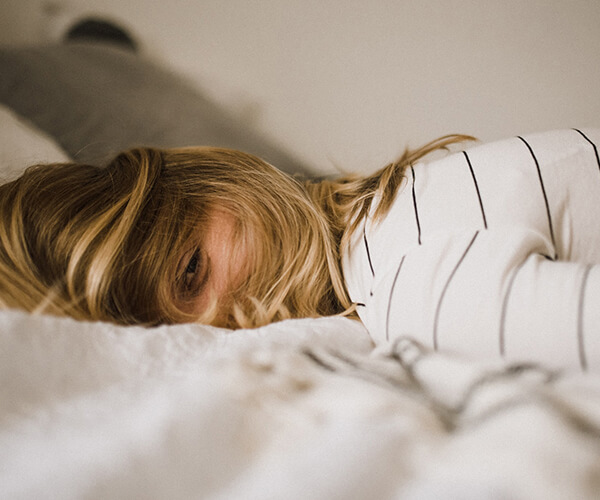
Uncertainty is one of the biggest drivers of anxiety and so it probably won’t surprise you to learn that anxiety among children and teenagers is rising. Our kids need our help to support their mental health and wellbeing more than ever before. Knowing that anxiety is defined as the brain and body’s reaction to the anticipation of a threat, it’s fair to say that we’re living that very definition right now. And though the threat of catching COVID-19 is low for most of us, with so many protective measures in place, the impact of our circumstances on mental health is prevalent, especially that of our kids. Here’s how you can help.
What do your children know about anxiety
Anxiety is a normal human emotion, and one that serves us all well when we’re in danger. It’s perfectly normal for all of us to be feeling anxious at the moment. That’s what keeps us vigilant about handwashing, keeping a social distance, wearing masks and staying home. When our children understand that anxiety is a normal human emotion, and like other emotions, it comes and goes (usually) and that it’s natural to be feeling more anxious at the moment – it helps them to cope. Teaching them to identify and name anxiety when it shows up, to understand why they’re feeling that way and to express and manage it in helpful ways all build their emotional intelligence and resilience over time.
As well as teaching our kids about anxiety, they need to know that they are capable of coping with the uncomfortable feeling it brings. Kids benefit greatly, over a lifetime, by learning to tolerate discomfort. When unable to tolerate discomfort, when unable to accept all feelings for what they are, we can all end up doing things that might make us feel a little better in the moment, but can make us feel worse, and have more to feel anxious about, over the long term.
Psychological distress is a challenge for all of us right now, it’s common. The number of people experiencing symptoms of anxiety and depression has doubled since the beginning of the pandemic. That said, while anxiety is high for many, most cases will settle. There will be some however, that progress towards an anxiety disorder, or exacerbate pre-existing anxiety. Some of the factors that increase the risk of developing an ongoing anxiety disorder include:
- Stress due to illness (self or loved one)
- Financial stress leading to economic disadvantage
- Mental health challenges in either parent
- Pre-existing mental health condition
- Indirectly or directly affected by the bushfires
- Aggression and violence in the home
- Self-esteem
What are the signs and symptoms of anxiety ?
Knowing how to recognise anxiety is imperative for parents. For many anxious kids years go by between experiencing symptoms and someone realising a need for professional help. Understanding the symptoms means kids who need help get it faster. Anxiety is often recognised by noticing a variety physical, emotional and behavioural changes including:
- Difficulty falling asleep
- Easily startled
- Picking at skin
- Hair pulling
- Excessive nail biting
- Avoiding social situations
- Difficulty separating from a parent or carer
- Headaches
- Upset stomach
- Lots of ‘what if?’ questions
- Becomes panicked or has panic attacks
- Reduced appetite
- Physically very tense
- Restless
- Easily distracted
- Avoids participating in groups
- Cries a lot
- Easily upset
- Trembling
- Numbness and/or tingling
- Avoidance
- Disruptive
- Difficulty completing schoolwork
- Easy to anger, often for no apparent reason
- Lots of worries
- Constantly seeking approval
- Perfectionism
- Lots of fears
The physical signs and symptoms of anxiety come about because when anxious, our bodies are powered up to protect ourselves by fighting or fleeing. All of the accompanying physical changes cause us to feel different physically. Blood is shunted from the digestive system to the major muscle groups to power us up to defend ourselves and so it makes sense that an upset stomach, stomach pains and even vomiting can accompany anxiety. Emotional responses also accompany anxiety because the part of the brain responsible for sounding the alarm bells, is also the emotional processing centre of the brain. Avoidance behaviours are also common as any potential danger is regarded as a genuine threat to safety. Steering clear of anything that amps ups anxiety, be it school, social situations or a Zoom meeting, is a protective response. The trouble being, any avoidance might settle anxiety in the short term, but the next time a child is faced with the same situation, their anxiety will likely be higher again.
How can parents help anxious kids?
- Empathise with them
We all appreciate and feel genuinely heard by someone when they listen to how we feel and validate for us that what we’re feeling is understandable. The opposite is true when we pour our heart out and are told all the reasons we shouldn’t feel the way we do. Our kids need the former approach from us, not the latter. This is what tells them they’ve been heard, understood, and have a soft place to land with us. It also helps keep lines of communication open for the next time they’re struggling. So very important.
2. Mindfulness for anxious minds
There are so many ‘what if?’ questions for anxious kids. Catastophising is common as is future thinking and lots of worrying. Helping them to bring their attention back to the present moment begins to settle their anxious brains. A simple approach of ‘notice this’ helps kids to be more present. Notice the sounds you can hear, notice the fur of your dog under your hand as you pat, notice ten things you can see around you. These are just a few ideas to get you started.
3. Progressive Relaxation
Muscles become locked and loaded for action when we’re anxious but so often, the tension isn’t released because of a lack of movement. Rarely, when the fight or flight system is triggered, do kids actually fight or flee. So often kids can be filled with anxiety but are lying in their beds under a lovely warm doona. Progressive relaxation, performed by tensing then relaxing a muscle group, helps to relieve this tension and helps kids relax.
4. Breathing to calm an anxious brain
The part of the brain that sounds the alarm when danger is detected is called the amygdala. One of the tangible ways we can show our brain we’re safe is through deliberate breathing using our diaphragm. Breathing is a powerful antidote to anxiety, helping us to shift control of our physiology from the predominant ‘fight or flight’ branch of the nervous system to the ‘rest and digest’ branch that enables us to think more clearly and feel more calm and centred. What you’ll find is that mindfulness apps teach guided breathing mindfulness exercises that combine the power of min5. dfulness and breathing in one. It’s no coincidence that often our first advice to anyone feeling highly stressed or anxious is to take a deep breath.
5. Prioritise your mental health as a parent
Any stress and anxiety we’re feeling will be felt by our children. Not an afterthought, as it is so often, our mental health and wellbeing set the tone for the rest of our family. Anxiety is contagious, so please take care of your own mental health too. What helps? Do you decompress by chatting to a friend? Through exercise? By doing a puzzle? Notice what makes a tangible difference to your own stress and make time to do what helps you to relax and settle your system. Our kids are always watching and so the role modelling aspect of what you do influences them now, and over a lifetime.
6. Anxiety support is only a click away
If you’re looking for trusted programs and support for your children to help them manage their anxiety, I’ve got you covered. There are a range of online options that can support you to understand more about anxiety, as well as programs to help your children develop anxiety management skills.
| Kids Helpline | Age-appropriate information for young children, teenagers and young adults (including information about managing anxiety related to news information), phone counselling, email and SMS services.Free app with short mindfulness exercises for children, teenagers and adults that parents and children can practise together easily. ‘Thriving Inside’ is a dedicated section of the Smiling Mind website and Instagram account that is related to managing COVID-19-related stress and maintaining connectedness. | Link here |
| Smiling Mind app | Free app with short mindfulness exercises for children, teenagers and adults that parents and children can practise together easily. ‘Thriving Inside’ is a dedicated section of the Smiling Mind website and Instagram account that is related to managing COVID-19-related stress and maintaining connectedness. | Link here |
| BITE BACK | An online program from the Black Dog Institute for adolescents aged 13–18 years based on positive psychology. It provides information, a mental health fitness challenge and activities such as ‘THINK TANK’ (a gratitude diary) and ‘SNAP THAT’ (a mindfulness activity disguised as a photography activity). The site focuses on developing and maintaining good mental health practices. | Link here |
| eheadspace | Free online support and counselling for young people aged 12–25 years. Although it is not an emergency service, the site does provide the option of one-on-one live chats from 9.00 am to 1.00 pm, as well as moderated group chats and excellent information for adolescents and families and friends. This site is useful for those wanting information, for tools addressing mild symptoms and for additional support between consultations. | Link here |
| Headspace clinical toolkit | Clinician guidelines for mental health disorders. | Link here |
| BRAVE-Online | An evidence-based cognitive behavioural therapy–based online program developed by The University of Queensland for children and teenagers with anxiety symptoms. It has a parallel program for parents to help them understand and manage what is occurring for their children. It can be undertaken independently by children and parents or has the option for assistance from an online therapist. | Link here |
When should you seek help for your anxious child?
Anytime you have concerns about your child’s mental health it’s important to seek professional advice from your GP. Anxiety in response to a threat, such as COVID-19, is a natural response but even so, when it starts to get in the way of daily activities, is impacting other family members and your child’s happiness, it’s a good time to check in with your family doctor for a conversation about what’s been happening. Keep an eye out for anxiety symptoms on more days than not during the week and record your observations in a notebook or on a device. Talking to your GP about your child’s anxiety can be stressful and can make it difficult to recall details of what’s been happening. Having some notes will help you to paint a clear picture of what’s been happening for your GP.
Where to seek help for your anxious child?
Your GP is always an excellent place to start when seeking help for your anxious child. It’s worthwhile booking a double appointment to allow yourself enough time to share details of why you’re concerned, and to give the GP time to support you and develop a plan for the next steps. Not all anxiety is a disorder, and often a GP will provide reassurance about developmental anxiety and anxiety that is a natural response to a stressful or threatening situation.


about
Jodi is on a mission to elevate mental health and wellbeing in families, classrooms and workplaces.


free 5-day
Calm your anxious brain
mini course

Recent Posts

free 5-day
Calm your anxious brain
mini course
Sign up for my free 5-day ‘Calm Your Anxious Brain’ email mini-course. Put the strategies into place for yourself, light the way for your kids, or do both.






